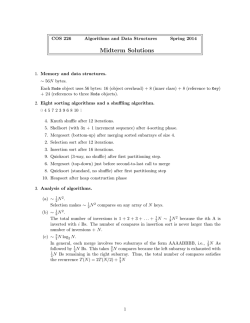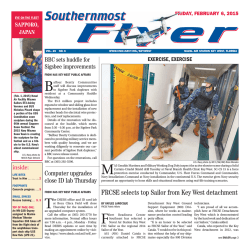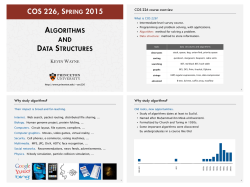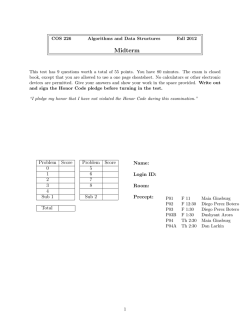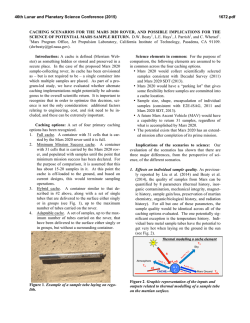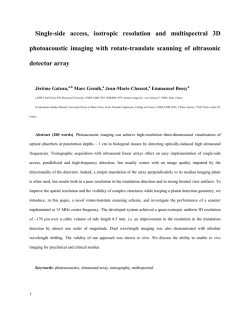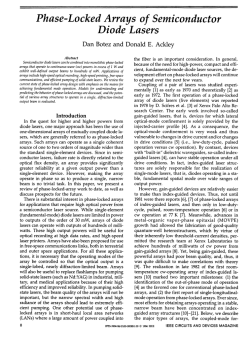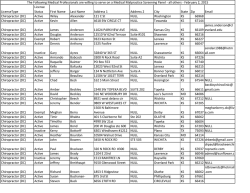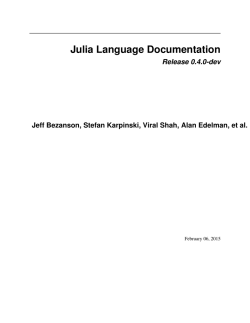
Midterm Solutions
COS 226 Algorithms and Data Structures Fall 2012 Midterm Solutions 1. Union find. ABC A. The id[] array contains a cycle: 8 → 2 → 4 → 0 → 8. B. The height of the forest is 4 > lg(10). C. The size of tree rooted at the parent of 3 is less than twice the size of tree rooted at 3. D. The following sequence of union operations would create the given id[] array: 2-0 1-8 7-9 0-9 8-5 4-1 1-9 3-8 5-6 2. Eight sorting algorithms. 0297685431 3. Analysis of algorithms. (a) ∼ N 2 Each of the N Bs must be compared and exchanged with each of the N As. (b) ∼ 3N The first partition uses ∼ 2N compares. After the first partition, all of the keys equal to the partitioning item (either all of the As or all of the Bs) will be finished. The second (and final) partition will complete the sort using ∼ N compares. 4. 3-heaps. Here is a drawing of the original 3-heap: Midterm, Fall 2012 88 33 10 9 30 66 77 25 23 60 7 1 75 14 21 50 (a) To delete-the-maximum, we exchange 88 with 7 and sink 7 down. To sink 7 down, we exchange 7 with its largest child (77) and then again exchange 7 with its largest child (75). 0 1 2 3 4 5 6 7 8 9 10 11 12 13 14 15 -- 77 33 75 66 10 30 25 23 60 7 14 21 50 9 -- (b) 3k − 1, 3k, 3k + 1 (c) ∼ 3 log3 N To sink a key, we repeatedly exchange it with its largest child (if the is less than the largest child). Identifying whether a key is less than its largest child requires 3 compares in the worst case. Since the height of a 3-heap is ∼ log3 N , the total number of compares in the worst case is ∼ 3 log3 N . 5. Red-black BSTs. 88 51 96 21 72 Midterm, 90 99 19 Fall 40 2012 61 86 13 24 To insert 99, we do two color flips, followed by one left rotation. Here is a drawing of the resulting red-black BST. 88 51 96 21 19 13 90 72 40 61 24 2 86 99 6. Problem identification. O. Given any array of N distinct integers, determine whether there are three integers that sum to exactly zero in time proportional to N 1.5 . I. Impossible P. Possible Conjectured that no such algorithm exists. O. Open P. Given any array of N distinct integers, determine whether there are three integers that sum to exactly zero in time proportional to N 2 . Discussed in precept. P. Implement a FIFO queue with a constant amount of memory plus two LIFO stacks, so that each queue operation uses a constant amortized number of stack operations. Discussed in lecture. P. Given any left-leaning red-black BST containing N keys, find the largest key less than or equal to a given key in logarithmic time. This is the floor function. I. Design a priority queue implementation that performs insert, max, and delete-max in ∼ 31 lg N compares per operation, where N is the number of comparable keys in the data structure. This would violate the ∼ N lg N lower bound for sorting because you can sort an array by inserting N keys into a maximumoriented priority queue and deleting the maximum N times. P. Given any array of N keys containing three distinct values, sort it in time proportional to N and using only a constant amount of extra space. Discussed in lecture as the Dutch National Flag problem. One solution is Dijkstra’s 3-way partitioning algorithm. O. Design a practical, in-place, stable, sorting algorithm that guarantees to sort any array of N comparable keys in at most ∼ N lg N compares. Described in lecture as the holy sorting grail. 3 7. LRU cache. (a) We use two data structures: • A doubly-linked list containing the N keys in the cache, with the most-recently cached key at the front and the least-recently cached key at the end. LRU cache data structure • A symbol table containing the N keys in the cache, where the value is a reference to the node in the doubly-linked list containing that key. To achieve the performance requirement, we use a linear probing hash table of capacity 2N for the symbol table. (A separate-chaining hash table would also work.) linear-probing hash table keys[] G vals[] null null null null null null H null C D null F null null doubly-linked list first H G D C F last (b) inCache(Key key): • Use the symbol table to determine whether the key is in the cache. (c) cache(Key key): • If the key is already in the cache, move the corresponding linked list node from its current position to the front of the list. • If the key is not already in the cache – remove the last node from the linked list (and remove the corresponding key from the symbol table) – add a new node to the front of the linked list with the given key (and add a corresponding entry to the symbol table) 4 95 8. Detecting a duplicate. (a) The main idea is to consider the N keys in ascending order, so that duplicate keys are adjacent. This is similar to the multiway merging algorithm on pp. 321–322 of the textbook. • Scan through adjacent entries in each of the k sorted array to check for any duplicate key within one of the original sorted arrays. If a duplicate is detected, stop. • Initialize a red-black BST with k key-value pairs, where the key is the first (smallest) key in the ith sorted array and the value is the index i of the array. • Repeat until the BST is empty or a duplicate is detected: – Delete the minimum key from the BST and let i be the index of the array associated with the deleted key. – If the next remaining key from array i is not already in the BST, add the key and associate it with the value i. – Otherwise, stop (duplicate detected). (b) The amount of space is proportional to k because the BST has at most k keys and we need to maintain one index into each of the k sorted arrays. The total running time is proportional to N log k. The bottleneck operations are insert and delete-min in a red-black BST. The cost per operation is log k because the BST has at most k keys. An alternate solution is to use a binary heap instead of a red-black BST. Some care is needed with this approach to ensure that you know from which sorted array the smallest key came. 5
© Copyright 2025
